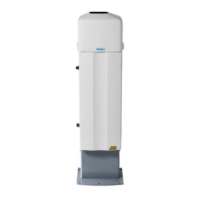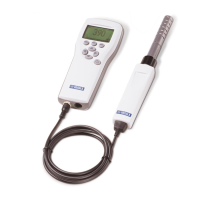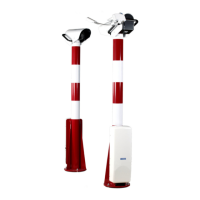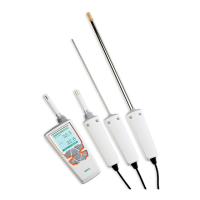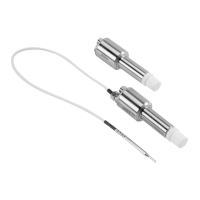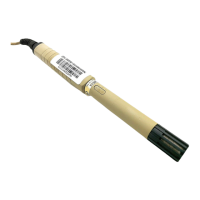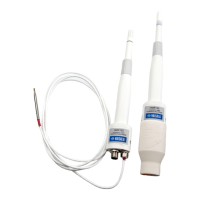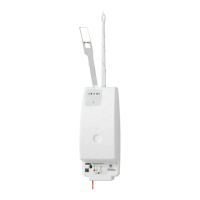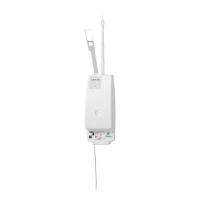Do you have a question about the Vaisala CT25K and is the answer not in the manual?
Describes the CT25K Ceilometer's function, technology, and capabilities.
Details the technical specifications of the CT25K Ceilometer, including mechanical, electrical, and performance aspects.
Provides dimensions, weight, and transport container specifications for the CT25K unit.
Specifies the connector type and mating connector for the window conditioner.
Details the power input connector, nominal voltage, and power consumption.
Describes the serial line standards and data port capabilities for outputting measurement data.
Lists available modem options (DMX55, DMX50) and their specifications.
Details the specifications of the laser transmitter, including source, wavelength, and power.
Details the specifications of the receiver, including detector, surface diameter, and filters.
Specifies optical system parameters like focal length, lens diameter, and transmittance.
Details performance metrics such as measurement range, resolution, and acquisition time.
Lists operating environmental conditions like temperature, humidity, and wind.
Provides instructions for safely unloading and unpacking the CT25K Ceilometer.
Describes the standard concrete foundation requirements and installation methods.
Outlines the four-stage process for assembling the CT25K Ceilometer unit.
Explains how to use the tilt feature for improved measurements and protection.
Details the external connectors (J1-J4) and how to make cable connections.
Explains the importance and method of grounding the instrument for safety.
Details connecting a maintenance terminal (PSION3/PC) for operation and maintenance.
Provides a step-by-step guide for powering up and initializing the CT25K Ceilometer.
Discusses operational aspects when using the CT25K in mobile configurations.
Explains how to check the CT25K's normal operation using a maintenance terminal.
Lists the required switch settings for the CT25K to operate normally.
Describes how to view and modify user-programmable parameters set at the factory.
Explains the two operation modes: continuous (NORMAL) and standby.
Describes the two serial communication ports and their states (OPEN/CLOSED).
Details user commands, their hierarchy, and how to use the interactive help system.
Explains the standard data messages provided by the CT25K, including format and interpretation.
Describes how to set up the CT25K to transmit messages based on predetermined polling strings.
Shows how to view current control and parameter settings using GET commands.
Explains how to disable automatic tilt angle measurement and set a manual value.
Explains the basic principle of operation of the CT25K Ceilometer using LIDAR technology.
Provides a general overview and detailed description of the CT25K's internal components and their functions.
Provides an overview of the measurement unit's internal layout and subassembly interconnections.
Explains the LIDAR measurement process, including signal acquisition and processing.
Describes how essential subassembly functions are monitored for accuracy and reliability.
Details the individual modules and subassemblies that comprise the CT25K Ceilometer.
Describes the optical subassembly, including its main units and optical cross-talk compensation.
Details the block diagram and operational description of the laser transmitter.
Explains the receiver's components, signal processing, and automatic gain/bandwidth control.
Describes the optics monitor's function in monitoring laser performance and window contamination.
Details the board frame, its subassemblies, and protective features against electromagnetic disturbances.
Describes the processor board's functions, components, and communication ports.
Details the DC converter's function, voltage generation, and LED indicators.
Explains the interface board's role in LIDAR backscatter signal acquisition and timing control.
Describes the subassembly responsible for AC power input, voltage transformation, and control relays.
Explains the internal heaters' function in maintaining lens and window temperature.
Details the tilt angle sensor's function in enabling accurate measurements in tilted directions.
Describes the window conditioner's components and function in clearing the unit window.
Details the PSION3 palmtop computer as an optional maintenance terminal.
Describes the DMX55 modem, its standards, and operational modes.
Describes the DMX50 modem, its supported standards, and operation.
Details the DMX611 interface for Vaisala proprietary ANet and INet busses.
Explains the algorithm used to calculate cloud cover and layer heights from time-series data.
Explains the algorithm used to calculate cloud cover and layer heights from time-series data.
Describes how to check for and interpret alarms and warnings in data messages.
Provides instructions for cleaning the unit's window to ensure clear measurements.
Outlines annual checks for battery condition and replacement guidelines.
Offers recommendations for storing the unit, including connector protection and dust covers.
Guides on checking normal operation, including equipment and step-by-step instructions.
Lists common warnings, their reasons, and instructions for resolution.
Details problems, reasons, and instructions for handling system alarms.
Covers miscellaneous problems, their causes, and suggested solutions.
Provides a systematic method for diagnosing the cause of malfunctions in the CT25K.
Outlines general principles and precautions for servicing and repairing the CT25K equipment.
Explains command syntax, notation, and conventions used in the repair section.
Details the initial steps and precautions before starting any subassembly replacement.
Covers procedures for removing, replacing, and adjusting the laser transmitter.
Covers procedures for removing, replacing, and handling coaxial cable issues for the receiver.
Details the procedure for replacing the compensation fiber and performing necessary adjustments.
Details the procedures for removing and replacing the optics monitor.
Covers the procedures for removing and replacing boards in the DMF51 frame, including DCT51 parameter settings.
Covers removal and replacement of CTP241, internal heater, and battery.
Describes the CT25K Ceilometer's function, technology, and capabilities.
Details the technical specifications of the CT25K Ceilometer, including mechanical, electrical, and performance aspects.
Provides dimensions, weight, and transport container specifications for the CT25K unit.
Specifies the connector type and mating connector for the window conditioner.
Details the power input connector, nominal voltage, and power consumption.
Describes the serial line standards and data port capabilities for outputting measurement data.
Lists available modem options (DMX55, DMX50) and their specifications.
Details the specifications of the laser transmitter, including source, wavelength, and power.
Details the specifications of the receiver, including detector, surface diameter, and filters.
Specifies optical system parameters like focal length, lens diameter, and transmittance.
Details performance metrics such as measurement range, resolution, and acquisition time.
Lists operating environmental conditions like temperature, humidity, and wind.
Provides instructions for safely unloading and unpacking the CT25K Ceilometer.
Describes the standard concrete foundation requirements and installation methods.
Outlines the four-stage process for assembling the CT25K Ceilometer unit.
Explains how to use the tilt feature for improved measurements and protection.
Details the external connectors (J1-J4) and how to make cable connections.
Explains the importance and method of grounding the instrument for safety.
Details connecting a maintenance terminal (PSION3/PC) for operation and maintenance.
Provides a step-by-step guide for powering up and initializing the CT25K Ceilometer.
Discusses operational aspects when using the CT25K in mobile configurations.
Explains how to check the CT25K's normal operation using a maintenance terminal.
Lists the required switch settings for the CT25K to operate normally.
Describes how to view and modify user-programmable parameters set at the factory.
Explains the two operation modes: continuous (NORMAL) and standby.
Describes the two serial communication ports and their states (OPEN/CLOSED).
Details user commands, their hierarchy, and how to use the interactive help system.
Explains the standard data messages provided by the CT25K, including format and interpretation.
Describes how to set up the CT25K to transmit messages based on predetermined polling strings.
Shows how to view current control and parameter settings using GET commands.
Explains how to disable automatic tilt angle measurement and set a manual value.
Explains the basic principle of operation of the CT25K Ceilometer using LIDAR technology.
Provides a general overview and detailed description of the CT25K's internal components and their functions.
Provides an overview of the measurement unit's internal layout and subassembly interconnections.
Explains the LIDAR measurement process, including signal acquisition and processing.
Describes how essential subassembly functions are monitored for accuracy and reliability.
Details the individual modules and subassemblies that comprise the CT25K Ceilometer.
Describes the optical subassembly, including its main units and optical cross-talk compensation.
Details the block diagram and operational description of the laser transmitter.
Explains the receiver's components, signal processing, and automatic gain/bandwidth control.
Describes the optics monitor's function in monitoring laser performance and window contamination.
Details the board frame, its subassemblies, and protective features against electromagnetic disturbances.
Describes the processor board's functions, components, and communication ports.
Details the DC converter's function, voltage generation, and LED indicators.
Explains the interface board's role in LIDAR backscatter signal acquisition and timing control.
Describes the subassembly responsible for AC power input, voltage transformation, and control relays.
Explains the internal heaters' function in maintaining lens and window temperature.
Details the tilt angle sensor's function in enabling accurate measurements in tilted directions.
Describes the window conditioner's components and function in clearing the unit window.
Details the PSION3 palmtop computer as an optional maintenance terminal.
Describes the DMX55 modem, its standards, and operational modes.
Describes the DMX50 modem, its supported standards, and operation.
Details the DMX611 interface for Vaisala proprietary ANet and INet busses.
Explains the algorithm used to calculate cloud cover and layer heights from time-series data.
Explains the algorithm used to calculate cloud cover and layer heights from time-series data.
Describes how to check for and interpret alarms and warnings in data messages.
Provides instructions for cleaning the unit's window to ensure clear measurements.
Outlines annual checks for battery condition and replacement guidelines.
Offers recommendations for storing the unit, including connector protection and dust covers.
Guides on checking normal operation, including equipment and step-by-step instructions.
Lists common warnings, their reasons, and instructions for resolution.
Details problems, reasons, and instructions for handling system alarms.
Covers miscellaneous problems, their causes, and suggested solutions.
Provides a systematic method for diagnosing the cause of malfunctions in the CT25K.
Outlines general principles and precautions for servicing and repairing the CT25K equipment.
Explains command syntax, notation, and conventions used in the repair section.
Details the initial steps and precautions before starting any subassembly replacement.
Covers procedures for removing, replacing, and adjusting the laser transmitter.
Covers procedures for removing, replacing, and handling coaxial cable issues for the receiver.
Details the procedure for replacing the compensation fiber and performing necessary adjustments.
Details the procedures for removing and replacing the optics monitor.
Covers the procedures for removing and replacing boards in the DMF51 frame, including DCT51 parameter settings.
Covers removal and replacement of CTP241, internal heater, and battery.
| Accuracy (Temperature) | ±0.2 °C |
|---|---|
| Resolution (Temperature) | 0.1 °C |
| Power Supply | 24 V DC |
| Humidity Measurement Range | 0 ... 100 %RH |
| Protection Class | IP65 |
| Output Signal | RS-485 |
